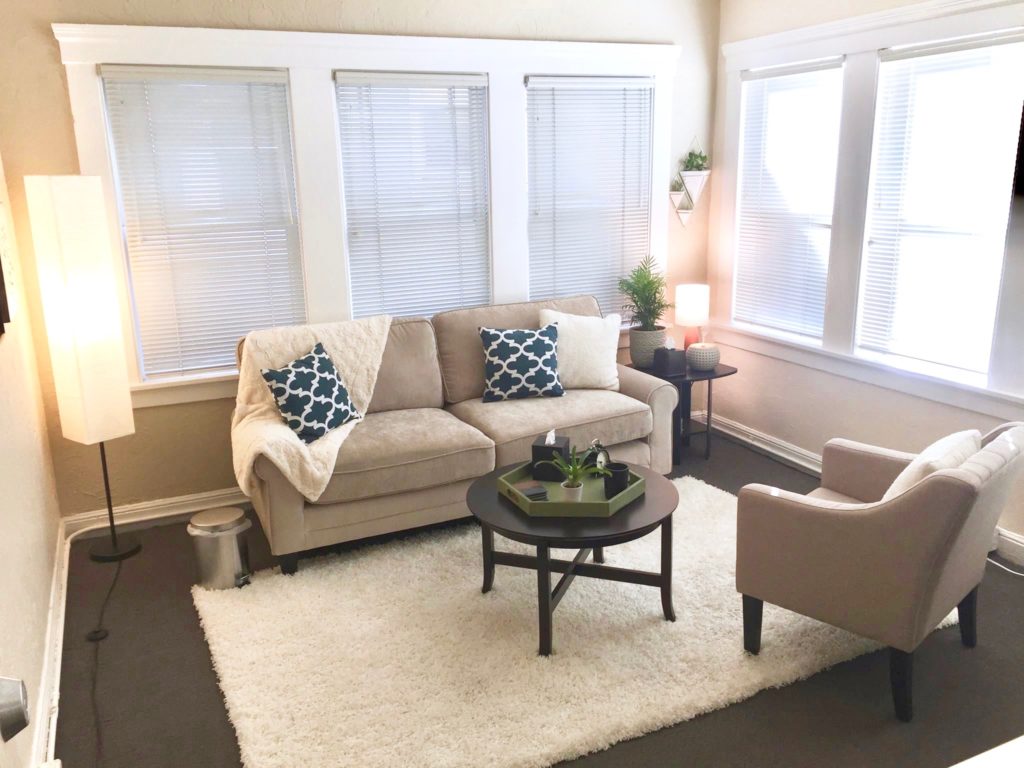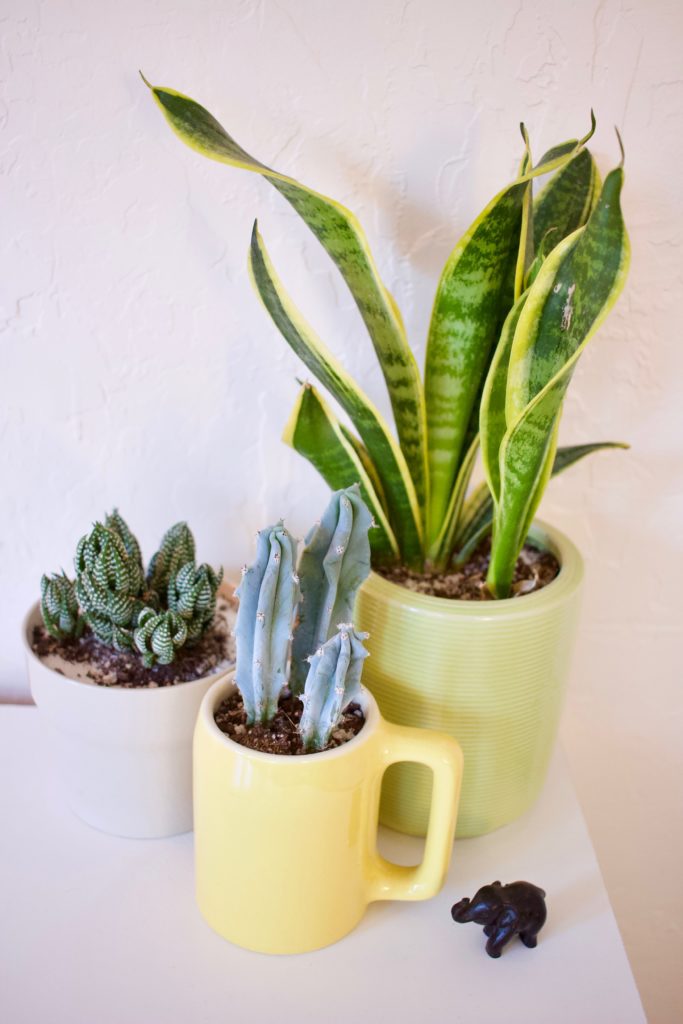I’ve seen my share of therapists thus far – six to be exact. And though the interior design of each of their offices didn’t have any correlation with their capacity to help me, the design of their offices significantly impacted how I felt while sitting together with them.
I’ve met with clients who told me they opted not to return to see a therapist after the first session because the design of their office was too messy or uninviting. They didn’t feel safe enough to open up.
The interior design of a therapist’s office is super important. But you don’t have to have a good eye for aesthetics or money oozing from your pores to create a space that’s warm and inviting for your clients. In today’s post, I break down my top tips for a therapist office interior design – even if you’re on a budget!

Top Tips: Therapist Office Interior Design
If you’re designing your office space from scratch, you don’t have to spend a fortune in order to create a welcoming space. Here are five key elements to consider when designing your office space.
1. Traffic Flow
Having a clear traffic flow through your office is the first step to making sure your office feels safe. If there are any obstructions in pathways or if it’s unclear what route to take to arrive at the proper seating, the space can feel awkward. Here are a few tips to ensure you have a smooth traffic flow in your therapist office interior design:
- Avoid placing any obstruction in the pathway between the door and the seating area for your clients.
- Avoid placing furniture close to the door that can make the space feel closed in.
- Have your client couch or chair pushed back all the way against a wall. This helps clients feel more grounded.
- Map out your office design from a bird’s-eye view to ensure there is a clear traffic flow in the space. You can use free software like RoomSketcher to design your office and see it from different angles.
2. Lighting
I have a pet peeve about bad lighting, but if you follow these tips you’ll get it right:
- If possible, welcome as much natural light as you can.
- Don’t use blackout curtains to block out all of the light (I see therapists do this often and I don’t understand it 🤷♀️)
- Avoid lighting the room exclusively from the ceiling. Overhead lighting makes us strain our eyes to see each other’s facial features. Use tabletop lamps to make it easier to see each other’s faces.
- Make sure your light bulbs are labeled as “soft white” or “warm white.” Do not use “bright light” or “daylight” bulbs as they strain our eyes and are jarring in an indoor space.
3. Textiles
Textiles help a space feel much homier. Take a look at this list and see if you might be able to include any of these in your office space:
- Blankets
- Pillows
- Rugs
- Curtains
- Wall hangings
To get super psychodynamic for a second, think of your office as a place for clients to feel like a cozy swaddled baby. Soft textiles bring a sense of warmth and “cozy” that make it much easier to feel safe and to build trust.
Pro tip: I like to keep a fuzzy blanket on my couch. Clients naturally place a hand on it while talking about uncomfortable subject matter. Sometimes, they full on snuggle underneath it. I’ve even seen clients grab the blanket and lie down on the floor. It’s nice to have objects like this to allow our clients the freedom to self-soothe and help themselves feel safe.
A rug that touches a foot of your client seating as well as your own chair helps to offer a sense of groundedness and connects the two of you together while allowing you to have a safe distance apart from each other.
4. Wall decor
Blank walls make a space feel like it’s not lived in. Consider using pieces that aren’t distracting to place on the wall.
You might also put your degrees, credentials, etc. on the wall to create a sense of credibility to the space.
5. Plants!

Plants are everything! (this is, of course, my totally unbiased opinion. No mind to the 100+ plants that are forming a mini jungle in my home ☺️)
In all seriousness, even if you have just one plant in your office, it makes all the difference. They pull double-duty as they both clean the air and help the place feel more alive.
Just be sure to replace any sick or dying plants, because that’s just bad PR.
Don’t have a green thumb? Start with a sansevieria plant (aka snake plant or mother-in-law tongue). It only needs to be watered about once a month, grows in almost all lighting conditions, and is rated by NASA as being highly effective at removing benzene and formaldehyde from the air. WIN!
Therapist Office Interior Design on a Budget
I purchased all my furniture and design elements in my office for under $1,200. All of the furniture I purchased brand-new from Wayfair and my design elements are all thrifted. If you ask me, I was able to furnish my office on a pretty low budget.
If you are on an even tighter budget, you can spruce up a room filled with Craigslist furniture by splurging on a couple of newer items that don’t break the bank, like some of your office textiles and a couple of plants.
If you get these tips right, then there’s no need to be too fussy about the rest of the design. Clients don’t notice how expensive an item is, they just notice how they feel when they come into the space.
Therapy Office Design No-No: Clutter!
Always, always, always keep ALL clutter out of your office. You don’t have to be a clutter-free person in general, you just need to find a way to hide your clutter from your clients.
If your clients see a cluttered office, they may question whether you’ll be able to help them “unclutter” their life, so to speak.
Final Design Tip: Be You!
Let pieces of your personality come through as these elements will help your space feel more like home. Feel free to have some of your favorite books, travel souvenirs, and pieces that add just a touch of appropriate humor on display in your office. Your clients will have a sense that you are a real human being if it looks like you’re not trying to hide who you are.
I hope these tips help the process of designing your therapist office feel more manageable for you (and dare I say joyful!).
If you’re still in the process of looking for an office, be sure to find your office first before designing it. Check out my post: How to Find a Psychotherapy Office Space
Ready to dive deeper into starting a private practice? I have a free guide for that! Check it out here to grab your free guide: Start a Private Practice in Counseling
Until next time, from one therapist to another: I wish you well.
-Marie
Photo by me ☺️
This blog post makes me realize how important is the interior of an therapist office as compared to the qualification of the therapist. Thanks for sharing this awesome content.
Absolutely! Our qualifications are of course of utmost importance, but a highly qualified therapist with an unwelcoming office is going to have a tough time creating the safety needed to do great work. Thanks for your comment!